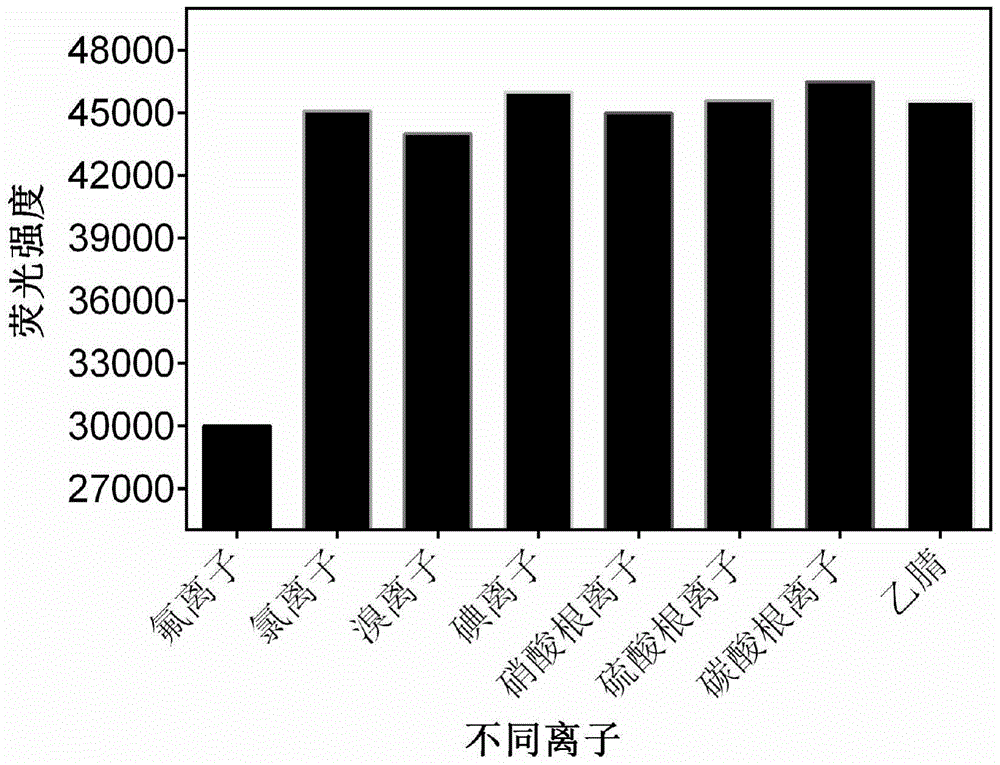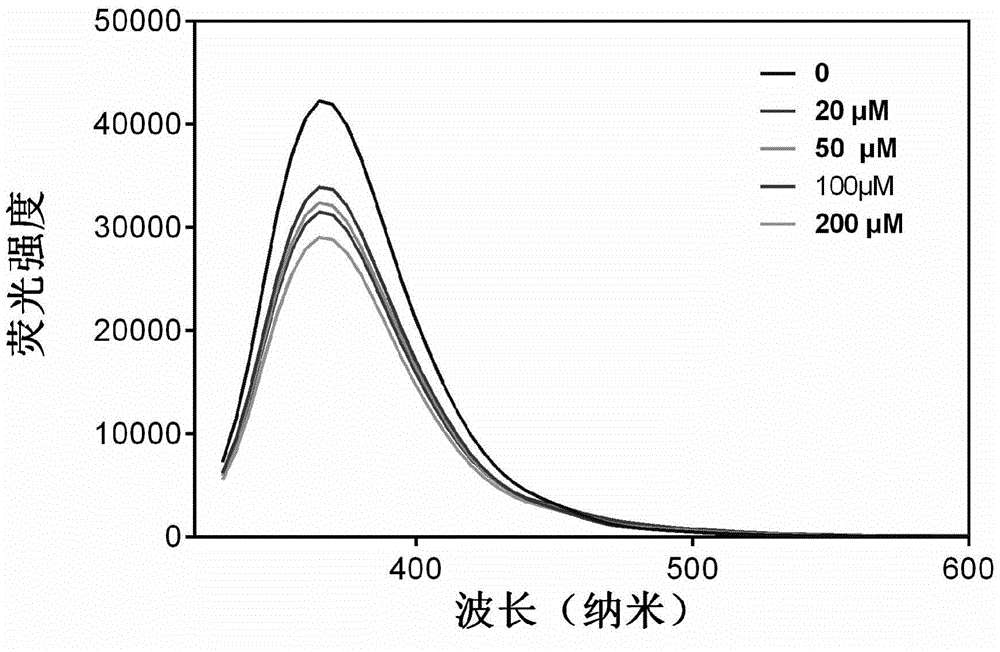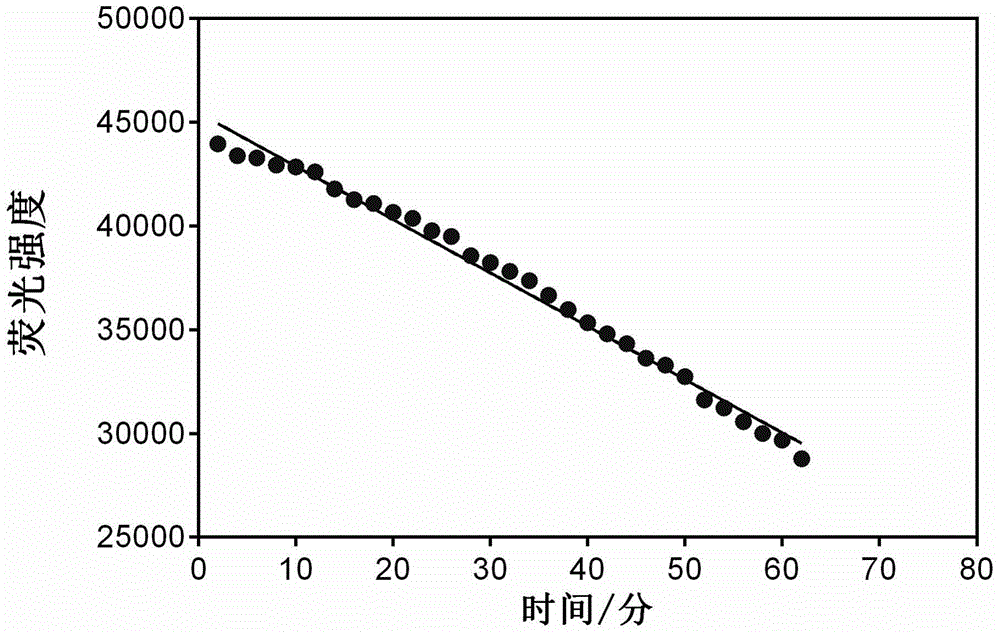Specific fluorescent probe for recognizing fluorine ions and application of specific fluorescent probe
A fluorescent probe and fluoride ion technology, applied in the field of specific fluorescent probes, can solve problems such as inconclusive fluoride ion concentration, and achieve the effect of simple and easy synthesis process and high sensitivity
- Summary
- Abstract
- Description
- Claims
- Application Information
AI Technical Summary
Problems solved by technology
Method used
Image
Examples
Embodiment 1
[0021] Example 1 Chemical synthesis of 2-(2-triisopropylsiloxyphenyl)benzothiazole
[0022] (1) Dissolve 0.5 mmol of 2-(2-hydroxyphenyl) benzothiazole and 0.625 mmol of triethylamine in 10 mL of tetrahydrofuran, dropwise add 5 mL of tetrahydrofuran containing 0.6 mmol of acetyl chloride under ice bath conditions, and stir for 8 h ;
[0023] (2) the reaction solution is distilled under reduced pressure to obtain a white solid residue;
[0024] (3) The solid was purified by silica gel chromatography and eluted with ethyl acetate-n-hexane (1:3 v / v) to obtain 116 mg of white solid powder. 1 H NMR (400MHz, CDCl 3 )δ8.39–8.27(m, 1H), 8.00(d, J=8.1Hz, 1H), 7.79(t, J=10.4Hz, 1H), 7.35(t, J=7.6Hz, 1H), 7.21( dt, J=9.2, 4.5Hz, 2H), 6.96 (t, J=7.5Hz, 1H), 6.87 (d, J=8.2Hz, 1H), 1.40 (td, J=15.0, 7.5Hz, 3H), 1.10–1.00 (m, 18H).
Embodiment 2
[0025] Example 2 Selectivity of 2-(2-triisopropylsiloxyphenyl)benzothiazole to different substances
[0026] (1) Prepare 99 μL of metabolic reaction system in advance, including acetonitrile, fluoride ion (100 μM), chloride ion (100 μM), bromide ion (100 μM), iodide ion (100 μM), nitrate ion (100 μM), sulfate ion (100 μM) , carbonate ions (100 μM);
[0027] (2) Add 1 μL of 2-(2-triisopropylsiloxyphenyl)benzothiazole with a final concentration of 10 μM to the reaction system to initiate the reaction;
[0028] (3) After 60min, perform fluorescence detection and calculate the fluorescence intensity in each system (see figure 1 ).
Embodiment 3
[0029] Example 3 Relationship between 2-(2-triisopropylsiloxyphenyl)benzothiazole and fluoride ion concentration
[0030] (1) Prepare 99 μL of metabolic reaction system in advance, including acetonitrile and fluoride ion (0-20 μM), and react at 25°C for 30 minutes;
[0031] (2) Add 1 μL of 2-(2-triisopropylsiloxyphenyl)benzothiazole with a final concentration of 10 μM to the reaction system to initiate the reaction;
[0032] (3) After 60 minutes, fluorescence detection was performed, and the fluorescence intensity in each system was calculated. (See figure 2 );
PUM
 Login to View More
Login to View More Abstract
Description
Claims
Application Information
 Login to View More
Login to View More - R&D
- Intellectual Property
- Life Sciences
- Materials
- Tech Scout
- Unparalleled Data Quality
- Higher Quality Content
- 60% Fewer Hallucinations
Browse by: Latest US Patents, China's latest patents, Technical Efficacy Thesaurus, Application Domain, Technology Topic, Popular Technical Reports.
© 2025 PatSnap. All rights reserved.Legal|Privacy policy|Modern Slavery Act Transparency Statement|Sitemap|About US| Contact US: help@patsnap.com



